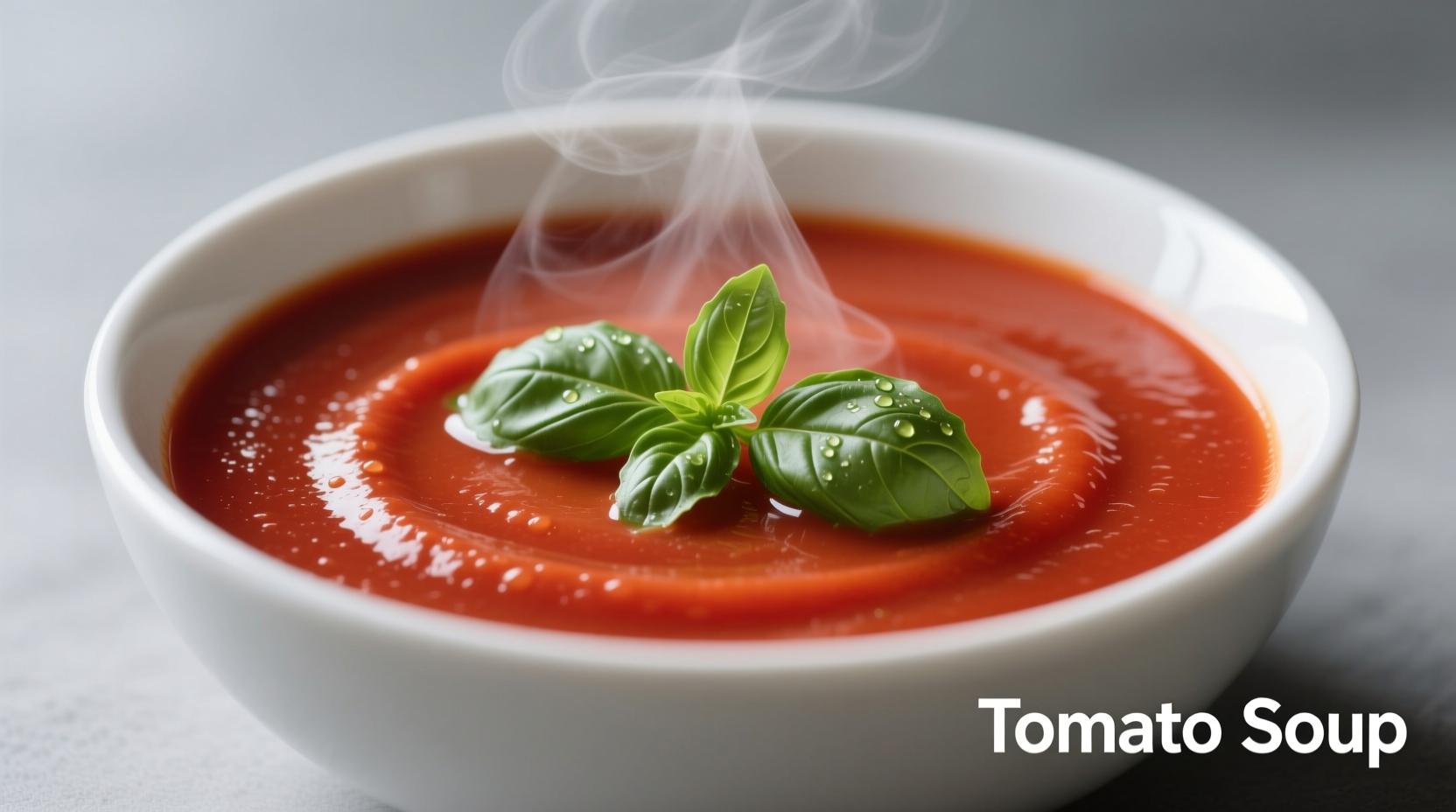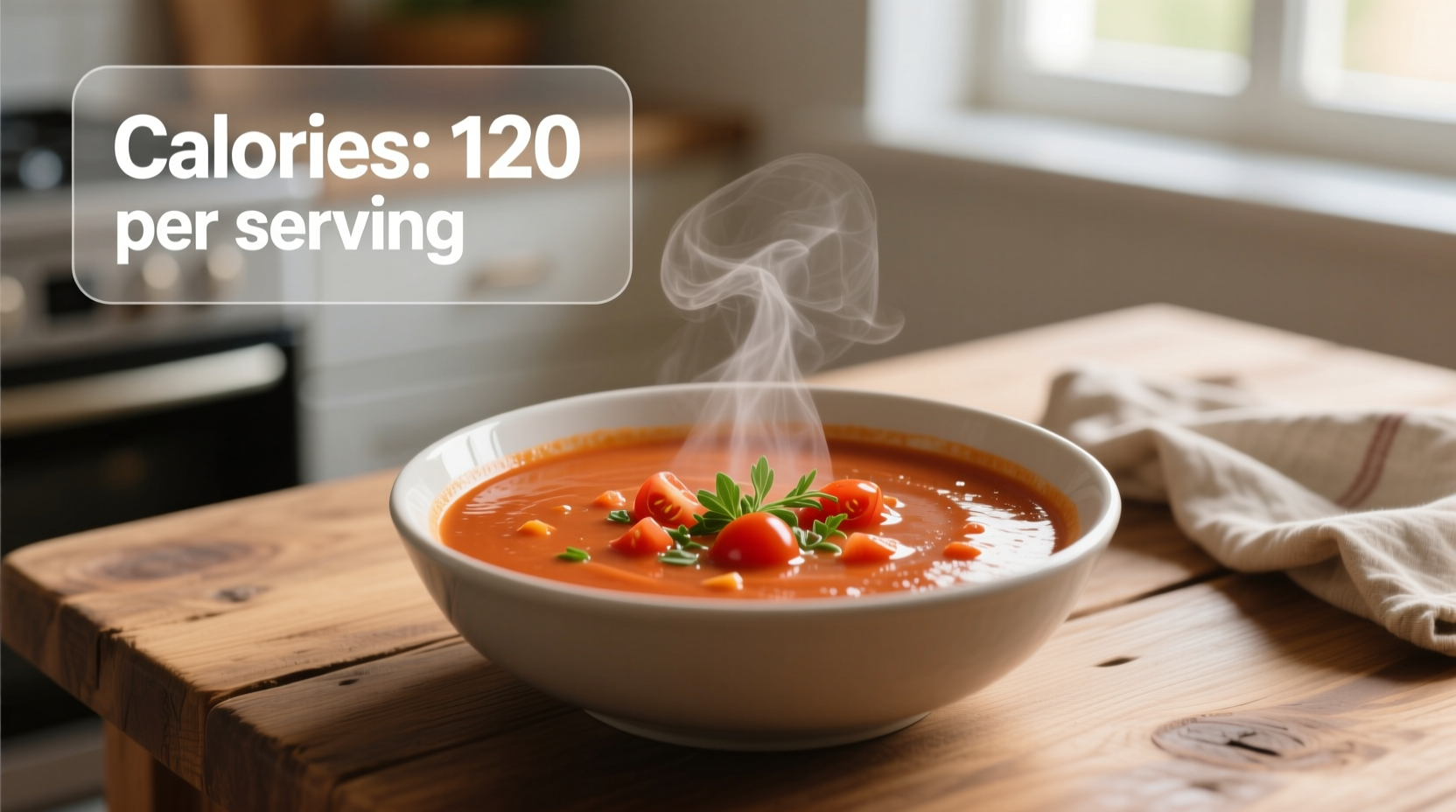Why Calorie Counts Vary in Tomato Soup
Understanding tomato soup calories requires examining preparation methods and ingredients. According to USDA FoodData Central, the base nutritional profile changes significantly based on whether you're using fresh tomatoes, canned tomatoes, cream, or broth as your foundation. Professional chefs like Antonio Rodriguez emphasize that "the cooking technique directly impacts calorie density"—simmering tomatoes longer concentrates natural sugars while adding dairy substantially increases caloric content.
Exact Calorie Counts Across Preparation Methods
| Preparation Method | Calories per 1-cup Serving | Key Ingredients |
|---|---|---|
| Basic Homemade (no cream) | 140-160 | Fresh tomatoes, onions, garlic, olive oil |
| Cream-Based Homemade | 190-220 | Tomatoes, heavy cream, butter |
| Low-Sodium Canned (Campbell's) | 100 | Tomato concentrate, water, modified food starch |
| Organic Canned (Amy's) | 170 | Organic tomatoes, onions, olive oil, herbs |
| Restaurant-Style (Panera) | 240 | Cream, butter, fresh herbs, croutons |
Nutritional Composition Breakdown
Tomato soup's calorie profile consists primarily of carbohydrates from natural tomato sugars, with smaller contributions from fats (when cream or oil is added) and minimal protein. A standard serving provides:
- Carbohydrates: 25-30g (100-120 calories)
- Fats: 2-8g (18-72 calories)
- Protein: 3-5g (12-20 calories)
The American Heart Association confirms that tomato-based soups generally offer favorable nutritional profiles when prepared without excessive cream or sodium. Their 2024 dietary guidelines note that sodium content often varies more dramatically than calories between commercial products.
How Preparation Affects Calorie Density
Professional chefs manipulate calorie content through specific techniques:
Calorie-Reducing Methods
- Water replacement: Substituting half the broth with water reduces calories by 15-20%
- Vegetable boosting: Adding zucchini or carrots increases volume without significant calorie addition
- Cream alternatives: Using evaporated skim milk instead of heavy cream cuts fat calories by 60%
Calorie-Increasing Factors
- Cheese additions: Parmesan (1 tbsp = 22 calories) or cheddar (1 oz = 114 calories)
- Cream enrichment: Heavy cream adds 50 calories per 2 tablespoons
- Crouton toppings: Restaurant-style servings often include 100+ extra calories from toppings

Historical Evolution of Tomato Soup Nutrition
Tomato soup's nutritional profile has shifted dramatically since its commercial introduction. Campbell's first condensed tomato soup (1915) contained just 60 calories per half-cup serving due to minimal ingredients. Modern versions have increased in calorie density through:
- Added cream for texture (post-1950s)
- Increased oil content for mouthfeel (1980s)
- Larger standard serving sizes (from 8oz to 12oz)
According to research published in the Journal of Food Composition and Analysis, contemporary tomato soups contain 35% more calories on average than versions from 40 years ago, primarily due to added fats and larger portions rather than changes in tomato content.
Practical Calorie Management Strategies
For those tracking dietary intake, these evidence-based approaches help manage tomato soup calories effectively:
Smart Shopping Guide
- Check serving sizes: Many "single serve" containers actually contain 2 servings
- Compare "per 100g" values for accurate brand comparisons
- Select low-sodium varieties which often contain fewer added fats
Home Preparation Tips
- Use an immersion blender instead of adding cream for thickness
- Add roasted red peppers for sweetness without extra sugar
- Include a small amount of tomato paste for richer flavor with minimal calories
When Calorie Counts Might Mislead
Understanding context boundaries is crucial for accurate dietary planning. Calorie counts become less reliable when:
- Restaurant portions vary significantly (a "cup" may actually be 1.5 cups)
- Homemade recipes use different tomato varieties (heirloom vs. Roma)
- Additional ingredients like croutons or cheese aren't accounted for
The USDA notes that actual calorie absorption can vary by 15-20% based on individual metabolism and food preparation methods, meaning labeled values serve as estimates rather than absolute measurements.
Maximizing Nutritional Value Per Calorie
Tomato soup offers exceptional nutrient density relative to its calorie count. A standard serving typically provides:
- 40% of daily vitamin C needs
- 25% of daily vitamin A requirements
- Significant lycopene content (enhanced when cooked with oil)
Registered dietitians consistently rank tomato-based soups among the most nutrient-dense comfort foods, particularly when prepared with minimal added fats. The key is balancing calorie awareness with overall nutritional benefits.











 浙公网安备
33010002000092号
浙公网安备
33010002000092号 浙B2-20120091-4
浙B2-20120091-4